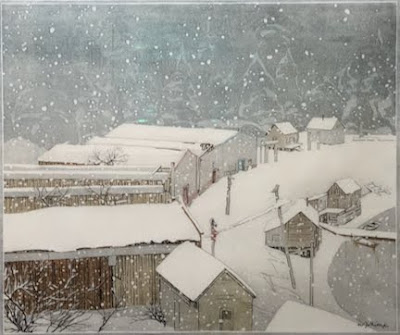Ken Burns, familiar to so many for his documentary films on American life, is a collector and aficionado of quilts. He appears in this film to share his enthusiasm for the medium, airing tonight on PBS.
For more information, go to the website:
 |
| this year's Christmas postcard |
 |
| Night on the Veranda, Christopher Pratt silkscreen, 1986 |
 |
| Eggs in Egg Crate, Mary Pratt oil, 1973 |
 |
| Jelly Shelf, Mary Pratt oil, 1999 |
 |
| Portrait of Cohen, Eric Mannella |
"This painting explores the idea of light revealing form, using a baroque model of lighting where the light source is a single beam. Emphasis is placed on a veristic likeness of the poet while conveying an introspective portrait of a deep thinker."
 |
| When Paper Becomes Poetry, Joanne Keilo |
"Cohen laments. Rather than bypass the glory and the pain, he permits himself to sink into it. He emerges through his poetry, through his songs, through his prose. In 'Beautiful Losers' Cohen writes 'How can I begin anything new with all of yesterday in me?'
"In my series 'When Paper Becomes Poetry' I beat the fibres for over eight hours in a Hollander beater. The overbeaten pulp is then placed in a squeeze bottle. Songs sung to me as an infant and as a child are formed from the pulp in the bottle and are written and re-written in spiral form. The lullabies and songs are finally transformed by the drying process when the pulp ultimately shrinks and undulates as it wishes, much like memories. This series confronts and transforms the subtle body of the baby's experience from paper into a kind of visual poetry."
 |
| Also by Joanne Keilo were these five works from her Close to the Bone series, comprised of large "leaf skeletons" incorporated into paper pulp. Detail shown below. |
"Cohen's words, 'There is a crack in everything, that's how the light gets in' remind me of the Japanese art of Kintsugi, repairing cracks in pottery with gold. This art form celebrates a beauty that is imperfect, and impermanent. The crack, the imperfection, becomes the source of new ideas, of growth and change."
 |
| Diaspora, Heather Dubreuil acrylic collage and paint, 20 x 20 |
 |
| From the series First, we take Manhattan, Heather Dubreuil |
 |
| I have tried in my way to be free, Heather Dubreuil hand-dyed linen, cording and stitch, 24 x 24 |
 |
| Femme au Chapeau, Pablo Picasso, 1941 oil on canvas, 24 x 14 7/8 in |
"I will never forget this scene. First, he did not paint with a brush but rather with what looked like a putty knife. Second, judging by the hundreds of empty tubes that lay at his feet, he was using a phenomenal quantity of paint. He did not unscrew his tubes. He decapitated them in one move with his knife without ever using the cap. Red, blue, or green: the colours appeared suddenly at the tip of his fingers. Because that is how he was doing it: he held all the tubes (say three or four or as many as his hand could hold) in his fist and then either poured them directly on the canvas or managed to have one colour mixing with the next by pressing the tubes in a certain way."
 |
| Karlukwees, BC, Walter Joseph Phillips, 1929 woodcut on paper, 10 1/2 x 12 1/2" |
 |
| La Seigneurie / Le manoir, Jean Paul Lemieux, 1973 oil on canvas, 16 3/4 x 26 3/4" |
 |
| Morning on the Inlet, A.J. Casson, 1959 oil on board, 24 x 45" |
 |
| Jean-Paul Riopelle, Perspectives, 1956 806 x 1000 mm |
 |
| What Lies Between, 2019 95 drawings, ink and coloured pencil on washi, each 21.75" x 6.75" |
 |
 |
| The Madness Driving Love No 3, 1966 |
 |
| Long Plumb Line No. 2, 1961 |
 |
| Loophole Crossing Blue, 1961 |
 |
| Temple of Joy, 1977. |
"By displaying works that span McEwen's near-fifty-year-long career, this exhibition underlines the understated monumentality, continuity and haunting beauty of his practice. The artist often used his hands to apply paint directly on the canvas, yet his paintings nonetheless eschew the drama of gesture, exploiting instead the intensity and expressiveness of colour. Their numerous successive layers of paint simultaneously suggest a rugged and polished surface while retaining a geometric structure and potent symbolic form that elude specific interpretation."
 |
| view of Albany's historic capitol building, surrounded by modernist government buildings |
"There is no relationship at all between buildings and site, neither at grade nor atop the podium, since all vestiges of the existing site have been so totally obliterated. Thus, as one stands on the Plaza itself, there is an eerie feeling of detachment. The Mall buildings loom menacingly, like aliens from another galaxy set down on this marble landing strip."The neighbourhood around the plaza is run-down, and includes a number of condemned buildings. Our innkeeper explained that the people who work for the state are well-paid, and want to live in the suburbs. What she didn't explain was that the centre of the city had been hollowed out by the evictions necessary to accommodate a modernist dream. I found out more about this history by reading the Wikipedia entry here.
 |
| This image of a hallway underlines the impressive nature of the state capitol building, built 1867-1899. The mosaic floor was laid piece-by-piece, by hand. |
 |
| Examples of fine craftsmanship abound. Much of the woodcarving was done on site, and the artisans were mostly immigrants from Scotland. |
 |
| Many of the materials were also imported, like this panelling of Italian marble. |
 |
| Originally, the building was to be capped with a dome, but the idea was scrapped due to structural concerns. |